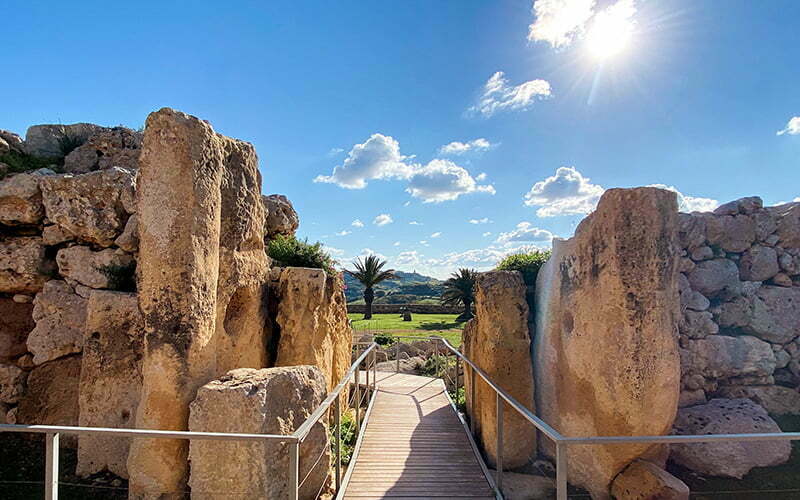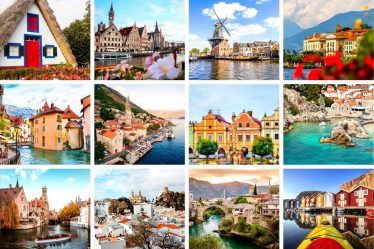
The Ggantija Temples are the second oldest freestanding, standing structures in the world, located on the Island of Gozo, one of the 3 islands that make up Malta. The Ggantija Temples are one of the most culturally and historically important places to see, not only on the Island of Gozo, but in all of Malta. Traces of one of the most mysterious civilizations in human history are here.
It was revealed by the radiocarbon method that the actual age of the temples was more than 5500 years old. This makes them the second oldest man-made religious structures in the world after Göbekli Tepe. It has a story that goes back even before the Egyptian Pyramids and Stonehenge. This megalithic complex made of limestone, which preserves its mystery, is on the UNESCO world heritage list.

Ggantija Temple
The Temple of Ggantija is the oldest temple in megalithic form ever found in Malta. Until recently, Ggantija was thought to be the world’s oldest independent archaeological monument. Until Göbekli Tepe in Urfa was discovered, the Ggantija Temples were the oldest standing temples in the world.
Before entering the temple area, there is a museum at the entrance that gives information about the archaeological find. Here you can see the most extensive collection of prehistoric artifacts found on the Island of Gozo, as well as exhibits of Neolithic life.
The first hall is on how the Ggantija Temples were built. Of course, there are ideas about how the locals moved such heavy and large stones. The most common of these ideas is to put small and round stones under the large stones and slide them. You can see these circular stones in the museum.
You can learn about the skulls, statuettes made by the local people, and information about the construction and location of the temple in the museum. After a few minutes’ walk from here, you come to the temple area by walking on wooden platforms.

The temples, which survived numerous invasions, looting and even natural disasters, were built between 3600 and 2500 BC. If you are an archeology enthusiast, you can admire the beautiful, completely stone facade of these huge monumental stones and giant stone towers, built in the form of clover leaves covered with wild flowers.
At the end of the 18th century, the French painter Jean Pierre Houel drew a realistic map of the temples with the information he received from the locals, before the excavations started. In 1827, the area was cleared of debris, but since the work was incomplete, it was lost again under the ground.
The painting that the German painter Brochtorff drew before the ruins of the region disappeared was a record of the existence of the temples. Archaeological excavations and preservation began much later, in the mid-20th century, when the temple was already badly damaged. The area, which was privately owned, was expropriated in 1933. Archaeological studies were carried out in 1933, 1936, 1949, 1956-57 and 1958-59 to protect and research the ruins in the region.
Considered an archaeological reference point to the most important periods of the Bronze Age, the stones on which the two temples found inside Ggantija are built are so large it’s no wonder the locals of Malta believe they were built by giants. The name Ġgantija is derived from the Maltese word ‘ġgant’ meaning giant.


It’s not so surprising why they thought so when you see the size of the limestone blocks from which it was built. Some megaliths exceed five meters in length and weigh over fifty tons. The inhabitants of the islands did not know the metals, and how Stone Age people made them is still a mystery.
Built with limestone blocks, each temple contains five apses connected by a central corridor leading to the innermost clover section. Wear-resistant coral limestone was used in the construction of the outer walls (one of the reasons why the structures have lasted so long). The softer, smoother Globigerina limestone was used in the doors, altars and decorative plates inside the temple.
Like other megalithic settlements in Malta, Ggantija faces southeast. There is evidence that the monuments have a layout and design associated with sunrise/sunset or moonrise/moonset.
Archaeologists believe that the apses were originally covered with a roof. The apses contain altars, possibly used for animal sacrifice. There is a large terrace in front of the temples that may have been used for ceremonial gatherings. This complex structure is an excellent display of prehistoric art.

The larger and older temple in the south is thought to have been built around 3600 BC. However, this place is better preserved than the new temple thought to have been built around 2500 BC.
Animal bones found in the temple suggest a kind of ritual involving animal sacrifice. In later periods, it was understood that some skeletons, skulls and long bones were separated from the body and buried in different special sections. This provides evidence that he organized a second burial some time after their deaths.
The existence of quarries also attests to the use of fire. A series of libation holes in the floor also gave information that it may have been used for pouring liquid offerings. The Ggantija Temples on Gozo are thought to be possibly the site of an Earth Mother Goddess Abundance Cult. Many figurines and statues believed to be related to this cult have been found in archaeological excavations.
The discovery of two red ocher plaster fragments inside the temple is suggested as evidence that the interior walls of the temple may once have been plastered and painted.

Some artifacts from Ggantija are on display at the Gozo Archaeological Museum. Also, some of the ornate stones of the temple can be seen in the archaeological museum in Valletta. I liked the museum, it is a museum that should be on your list of places to visit in Malta. The entrance fee to Ggantija is 8€.
In total, the remains of 30 temples have been discovered on the islands of Malta and Gozo. When you have time, you can also add Ħaġar Qim-Mnajdra, Ta’ Ħaġrat Temples, Skorba Temples and Tarxien Temples, which are other valuable temples, to your visit list.
Getting to the Ggantija Temples
The Ggantija Temples are located approximately 3 km from Victoria, the capital of the Island of Gozo. The easiest way to reach the temples is to take a direct 10-minute bus from Victoria Coach Station. For those who drive, the entrance is on St John Otto Bayer. There is free parking in the museum area.
Malta, which has an important place in the history of the Mediterranean and Europe, has a deep-rooted history of humanity with its ancient history stretching back 7 thousand years. You can find much more detailed information about Malta at maltatatili.com .
Ggantija Temples is a UNESCO world heritage megalithic complex on Malta’s sister Island of Gozo. Malta is a valuable heritage that you should prioritize on your list of places to visit.


